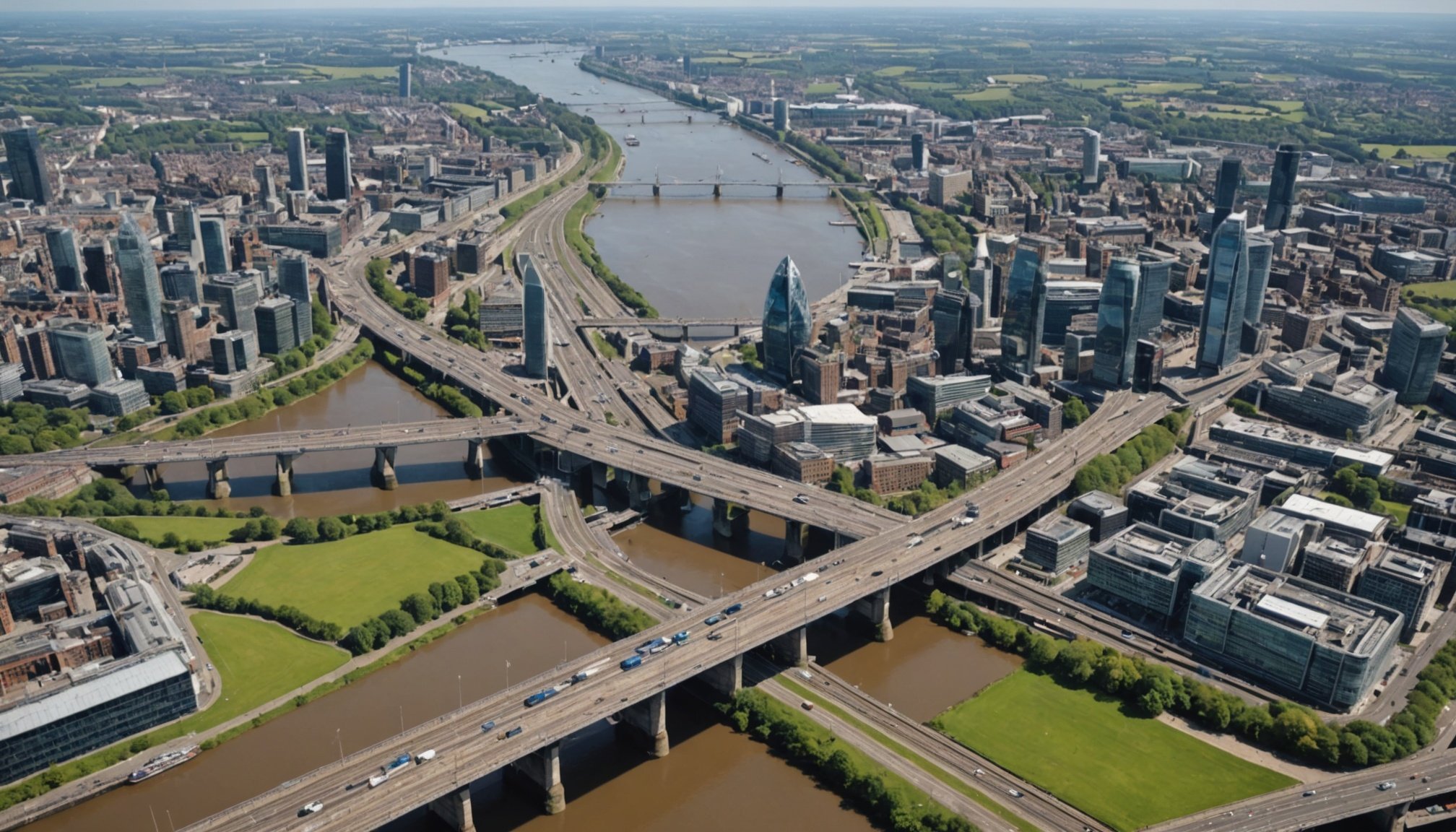Transforming UK Infrastructure: Harnessing Digital Twins for Innovative Development Solutions
In the ever-evolving landscape of modern infrastructure, the UK is on the cusp of a revolutionary transformation, driven by the innovative power of digital twins. These virtual replicas of physical systems are not just a technological novelty; they are a game-changer in how we design, manage, and experience our infrastructure. Here’s a deep dive into how digital twins are reshaping the UK’s infrastructure, from transport to sustainable development.
The Concept of Digital Twins
Digital twins are virtual models of physical assets, systems, or processes. They use real-time data to mirror the behavior of their physical counterparts, enabling real-time monitoring, predictive maintenance, and optimized performance. In the context of infrastructure, this technology is particularly powerful.
Have you seen this : Luxury real estate in Mauritius: Discover premium property options
“Digital twins offer the potential to improve the UK’s public transport efficiency across all modes,” notes Ryan Hood, digital highways leader at Arup, highlighting the transformative impact of this technology on the transport sector[1].
Enhancing Transport Infrastructure
One of the most significant applications of digital twins is in the transport sector. Here, they are revolutionizing how we manage and integrate different modes of transport.
Also to discover : Revolutionizing workplace safety: how exoskeleton technology is preventing injuries among uk workers
Seamless Multimodal Integration
Digital twins enable the integration of surface, maritime, and air traffic into a unified system. This is not just theoretical; it is already delivering measurable benefits. For instance, Transport for London’s Surface Intelligent Transport System (SITS) uses digital twins to prioritize buses, improve traffic flow, and enhance air quality across the capital.
- Optimizing Connections: Digital twins optimize connections between buses, trains, trams, air travel, and even active transport modes like cycling and walking, significantly reducing delays, congestion, and emissions.
- Real-Time Data Sharing: Real-time data sharing is central to this integration. For example, Portsmouth City Council’s ferry tracking system uses digital twin approaches to monitor timetables and anomalies, supporting smoother transitions between maritime and road transport[1].
Rapid Incident and Emergency Response
Unplanned incidents are a common challenge for transport networks. Digital twins address this by providing a comprehensive, real-time view of the network, enabling swift and coordinated responses to incidents and emergencies.
- Centralised Dashboards: Centralised dashboards powered by digital twins consolidate incident data from multiple sources, allowing operators to identify problems quickly and deploy the necessary resources.
- Predictive Tools: Predictive tools analyse historical and real-time data to anticipate and mitigate future disruptions. Transport for West Midlands’ multimodal dashboard and incident management system are prime examples of how digital twins can streamline communication between transport authorities, emergency services, and government agencies[1].
Unlocking the Power of Data
At the heart of digital twin technology lies its ability to integrate and leverage vast amounts of data. This capability is crucial for several reasons:
Data-Driven Decision Making
Digital twins facilitate collaboration between transport operators and adjacent sectors, improving decision-making and supporting innovation. For example, Network Rail’s ENRICH programme uses data-driven insights to enhance remote monitoring of rail infrastructure, reducing delays and maintenance costs[1].
Artificial Intelligence and Efficiency
Digital twins also facilitate the adoption of cutting-edge technologies like artificial intelligence. AI can analyse transport patterns to optimise journeys and improve network performance. By addressing barriers to data sharing and promoting interoperability, digital twins pave the way for a truly integrated and efficient transport system.
Sustainable Infrastructure Development
Beyond transport, digital twins are playing a pivotal role in sustainable infrastructure development.
Optimising Green Infrastructure
Digital twins can help in optimising green hydrogen plants, managing critical water resources, and reducing non-revenue water (NRW). For instance, by leveraging digital twins, water utility operators can import pump performance data, manage their water supply network, and compare operational data with pump curves to assess efficiency. This can lead to a significant reduction in NRW, which has a substantial economic impact globally[3].
Extending Asset Lifecycles
Digital twins promote circularity by extending the lifecycles of diverse assets. By monitoring and managing infrastructure assets in real-time, digital twins can help in identifying areas that need maintenance or replacement, thereby reducing waste and enhancing sustainability.
Economic and Environmental Benefits
The economic and environmental benefits of adopting digital twins are substantial.
Economic Gains
Research indicates that implementing integrated transport digital twins could deliver £1.85 billion in economic benefits over a decade, including gains from improved journey quality, reliability, and environmental outcomes. This economic case is strong and underscores the importance of widespread adoption and collaboration[1].
Environmental Impact
Digital twins can significantly reduce emissions and improve air quality. By optimising transport networks and reducing congestion, they contribute to a more sustainable environment. Additionally, their role in managing water resources and reducing NRW helps in conserving this vital resource.
A Roadmap to Adoption
While the benefits of digital twins are clear, their full potential can only be realised through widespread adoption and collaboration.
Challenges and Solutions
Challenges such as standardisation, interoperability, and cross-sector cooperation must be addressed. The good news is that initiatives like techUK’s Digital Twins Working Group are playing a pivotal role in enabling the UK’s digital twin ecosystem to flourish. This group serves as a critical source of advice for decision-makers responsible for policy, regulation, and investment in this sphere[2].
Government Support and Collaboration
The UK government is actively supporting the adoption of digital twins. For example, the Department for Transport has commissioned research on the transformational impact of data-driven digital twins on transport networks. Such initiatives highlight the government’s commitment to leveraging technology for public services and infrastructure development[1].
Case Studies and Practical Insights
Several case studies illustrate the practical benefits of digital twins in real-world scenarios.
Transport for London (TfL)
TfL’s use of digital twins in its SITS demonstrates how this technology can improve traffic flow and air quality. By prioritising buses and optimising traffic signals, TfL has seen significant improvements in journey times and overall transport efficiency[1].
Network Rail
Network Rail’s ENRICH programme is another example of how digital twins can enhance infrastructure management. By using data-driven insights, Network Rail has reduced delays and maintenance costs, showcasing the potential of digital twins in improving the reliability and efficiency of rail infrastructure[1].
Table: Benefits of Digital Twins in Infrastructure
| Benefit | Description | Example |
|---|---|---|
| Multimodal Integration | Integrates different modes of transport into a unified system. | Transport for London’s SITS |
| Incident Response | Provides real-time view for swift and coordinated incident responses. | Transport for West Midlands’ multimodal dashboard |
| Data-Driven Decision Making | Facilitates collaboration and improves decision-making. | Network Rail’s ENRICH programme |
| Sustainable Development | Optimises green infrastructure and manages critical resources. | Water utility operators reducing NRW |
| Economic Gains | Delivers significant economic benefits through improved efficiency. | £1.85 billion in economic benefits over a decade |
| Environmental Impact | Reduces emissions and improves air quality. | Optimising transport networks and reducing congestion |
Future Outlook and Challenges
As the UK continues to embrace digital twin technology, there are several challenges and opportunities to consider.
Standardisation and Interoperability
Standardisation and interoperability are crucial for the widespread adoption of digital twins. Initiatives like techUK’s Digital Twins Working Group are working towards these goals, ensuring that the UK’s digital twin ecosystem can flourish[2].
Security and Privacy
With the increased use of digital data, security and privacy become paramount. Ensuring that digital twin systems are secure and compliant with data protection regulations is essential for maintaining public trust.
Government and Regulatory Support
Government support and regulatory frameworks are vital for the adoption of digital twins. The UK government’s initiatives, such as the research commissioned by the Department for Transport, demonstrate a commitment to leveraging this technology for public services and infrastructure development[1].
Digital twins are not just a technological innovation; they represent a paradigm shift in how we design, manage, and experience infrastructure. By enabling seamless integration, enhancing emergency responses, and unlocking the power of data, digital twins can help deliver improved transport outcomes and sustainable infrastructure solutions.
As Rodrigo Fernandes of Bentley Systems aptly puts it, “Digital twins are key to future-proofing infrastructure,” accelerating the transition towards a sustainable future and supporting healthy, growing communities[3].
In the words of Ryan Hood, “Digital twins need to be seen as more than just a technological innovation. Rather, they must be viewed as a paradigm shift in how we design, manage and experience transport”[1].
As we move forward in this digital transformation, it is clear that digital twins will play a central role in shaping the future of the UK’s infrastructure, driving economic growth, and ensuring a sustainable built environment for generations to come.





